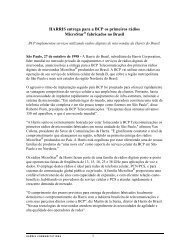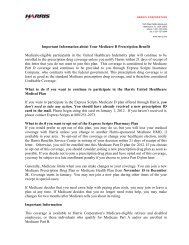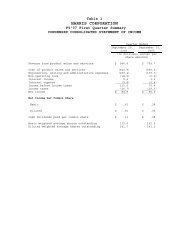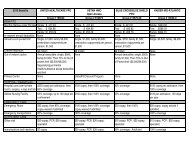METHOD OF ALLOCATING MULTIPLE ASYNCHRONOUS DATA ...
METHOD OF ALLOCATING MULTIPLE ASYNCHRONOUS DATA ...
METHOD OF ALLOCATING MULTIPLE ASYNCHRONOUS DATA ...
Create successful ePaper yourself
Turn your PDF publications into a flip-book with our unique Google optimized e-Paper software.
compound timeslots not been employed. Therefore, it is<br />
imperative that an algorithm be used that will result in the<br />
lowest number of channel fragments per service in order to<br />
reduce the additional overhead of utilizing compound services.<br />
7.3. OVER ALLOCATION <strong>OF</strong><br />
CHANNEL SPACE<br />
The last consequence of utilizing compound timeslots,<br />
which will be covered in this paper, is the possible over<br />
allocation of channel space to a service request. Because<br />
the main goal of allocating two or more channel fragments<br />
to a single timeslot was to prevent the service request from<br />
being under fulfilled, the possibility of over-allocating<br />
channel space in response to a service request has not been<br />
prevented. Therefore, the algorithm utilized to recover the<br />
residual channel space must also carefully balance the<br />
need to minimize the number of residual channel fragments,<br />
usually by selecting the larger fragments, with the<br />
desire to minimize the amount of channel space over allocation<br />
by splitting residual channel space into two or more<br />
timeslot fragments.<br />
8. HEURISTIC ALGORITHMS<br />
Because computing the optimal usage of residual channel<br />
space fragments while taking into consideration the aforementioned<br />
consequences of utilizing compound timeslots<br />
is similar to the traditional bin packing problem, and therefore<br />
is a combinatorial NP-Hard 2 problem, the utilization<br />
of a heuristic algorithm for this task within an IW communications<br />
system would be ideal.<br />
Heuristic algorithms are a category of algorithms that are<br />
capable of arriving at a solution to a problem much faster<br />
than typical brute force methods, such as purely computing<br />
every possible solution and choosing the most favorable.<br />
Given that arriving at a perfect solution to an NP-Hard<br />
problem is not likely without attempting every possible<br />
combination, heuristic algorithms are capable of providing<br />
improved run time performance by relinquishing the ability<br />
to guarantee an optimal result. Through the selection of<br />
a heuristic algorithm with a provable lower bound [6], we<br />
can be assured that an arbitrarily bad solution will not be<br />
generated during the usage of the residual channel space<br />
for compound services.<br />
8.1. INITIAL SERVICE ALLOCATION<br />
While the traditional BF algorithm is widely regarded as<br />
the best overall on-line bin packing algorithm, and is useful<br />
for the initial allocation of normal services within an<br />
IW communications system, a modified version must be<br />
employed when utilizing residual channel space fragments<br />
2 NP-Hard problems are intrinsically harder than those that can be<br />
solved by a nondeterministic Turing machine in polynomial time [8].<br />
Paper ID# 900150.PDF<br />
5 of 7<br />
to overcome the aforementioned consequences of compound<br />
services by minimizing the number of residual<br />
channel fragments and limiting channel space over allocation.<br />
Furthermore, the computational complexity of O (n)<br />
ensures that the modified BF algorithm minimally impacts<br />
the run time performance of initial service allocation.<br />
Figure 5: Initial Compound Service Allocation Diagram<br />
To utilize the modified BF algorithm the Network Management<br />
System will continue to allocate services as normal<br />
until a service that can be allocated with a compound<br />
timeslot is requested and there is insufficient contiguous<br />
channel space in the other channels in use to accommodate<br />
the service request (Figure 5). When this occurs, the Network<br />
Management System will attempt to fulfill the service<br />
request by allocating a compound timeslot. Utilizing<br />
the modified BF algorithm, the Network Management System<br />
accomplishes this task by first creating a list of the<br />
channel fragments available in all channels in which one<br />
or more services are allocated and sorting the residual<br />
channel fragment list in descending unallocated space order.<br />
After the channel fragment list has been sorted, the<br />
protocol will iterate over the list of fragments and select<br />
the fragments in which the difference between the residual<br />
channel space and the requested channel capacity is minimized<br />
in order to minimize the number of residual channel<br />
fragments and limit channel space over allocation (Figure<br />
6). If there are insufficient channel fragments to fulfill the<br />
service request then a new channel will be utilized to compensate<br />
for the difference between the amount of channel<br />
space requested and that acquired from the residual channel<br />
fragments. If the IW communications system has been<br />
over-allocated, and therefore there is insufficient available<br />
satellite channel space for fulfilling the service request, the<br />
Network Management System will allocate as much space<br />
as possible and inform the system operator. The operator<br />
may then resolve the issue by either giving the new service<br />
request priority over other currently active services or disregarding<br />
the service request error.
















